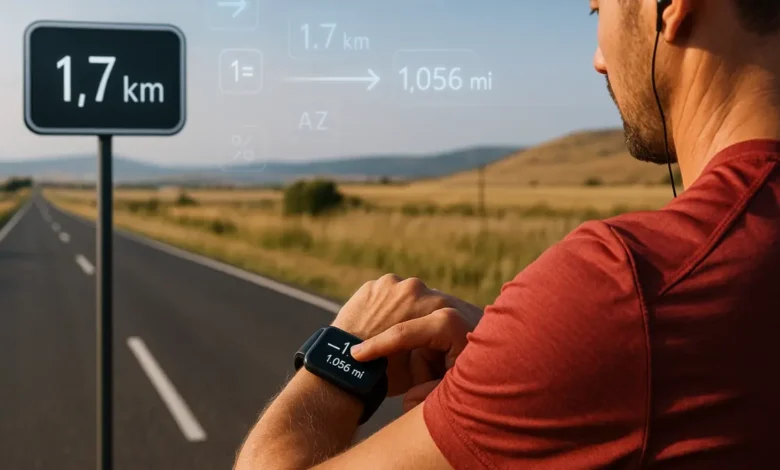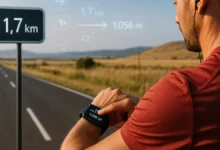1.7 km to miles – Understanding the Conversion Like an Expert

Learn how to easily convert 1.7 km to miles and understand what it means in real life. Accurate conversion, examples, and FAQs explained by experts in simple, clear language.
Converting 1.7 km to miles might sound simple, but understanding what lies behind this conversion can make a big difference—especially if you’re dealing with fitness tracking, navigation, travel, or scientific calculations. The world uses kilometers in most countries, while the United States and the UK often rely on miles. That’s why knowing how to convert 1.7 km to miles accurately helps bridge this measurement gap smoothly.
When someone says “it’s about 1.7 kilometers away,” you might picture a short walk or a quick drive. But how far is that really in miles? The straightforward answer is:
1.7 kilometers equals approximately 1.056 miles.
Still, the journey from kilometers to miles involves more than just numbers. It’s about understanding how different parts of the world measure distance and why the conversion exists in the first place.
What Does It Mean to Convert 1.7 km to Miles?
Converting 1.7 km to miles simply means translating a distance measured in kilometers—a metric unit—into miles, which belong to the imperial system. These two systems coexist, and understanding how to move between them gives clarity to measurements across borders and contexts.
A kilometer, abbreviated as “km,” is a metric unit of length that equals 1,000 meters. A mile, on the other hand, is an imperial unit commonly used in countries like the United States and the United Kingdom. One mile equals approximately 1.609 kilometers. Therefore, when we convert 1.7 km to miles, we divide by 1.609 to get the equivalent in miles.
In short:
1 kilometer = 0.621371 miles
1.7 kilometers × 0.621371 = 1.05633 miles
This simple equation forms the foundation of all kilometer-to-mile conversions.
The Importance of Understanding Distance Conversion
Knowing how to convert 1.7 km to miles goes beyond academic curiosity. It’s practical knowledge that can be used in everyday situations—from traveling abroad to logging your morning run.
Imagine you’re traveling through Europe, where road signs and fitness trackers use kilometers, but you’re more familiar with miles. Understanding the conversion helps you estimate distances intuitively. Similarly, if your car’s GPS gives directions in kilometers, converting them to miles ensures you have a better mental grasp of how far your next turn really is.
For example, 1.7 kilometers—just over one mile—is roughly a 15–20 minute walk at a moderate pace. That’s about the distance between two nearby city blocks or a quick jog through a park.
Another scenario is fitness tracking. Many runners use smartwatches that measure in kilometers, while others prefer miles. Knowing how to interpret 1.7 km in miles helps compare workout logs or follow international training plans.
The Formula Behind 1.7 km to Miles Conversion
To convert 1.7 km to miles, we use a straightforward mathematical relationship based on fixed unit definitions.
Formula:
Miles = Kilometers × 0.621371
Applying the formula:
1.7 × 0.621371 = 1.05633 miles
This result tells us that 1.7 kilometers equals approximately 1.06 miles when rounded to two decimal places.
Conversion Table
| Kilometers | Miles (Approximate) |
|---|---|
| 1.0 km | 0.621 miles |
| 1.5 km | 0.932 miles |
| 1.7 km | 1.056 miles |
| 2.0 km | 1.243 miles |
| 5.0 km | 3.107 miles |
This table shows how distances scale when converting between these two units, making it easier to visualize.
Understanding the Metric and Imperial Systems
To appreciate the meaning of 1.7 km to miles, you first need to grasp the difference between the metric and imperial systems.
The metric system—used in most countries—is decimal-based, meaning it’s structured around units of ten. It’s logical, simple, and universally consistent. That’s why scientists, engineers, and most of the world prefer it.
The imperial system, on the other hand, relies on traditional units like miles, feet, and inches. It’s not decimal-based but remains culturally significant in regions like the United States and the UK.
So, while someone in France might say, “The café is 1.7 kilometers away,” an American might say, “It’s about a mile.” Both mean roughly the same thing, but each uses a different measuring system rooted in history and local habit.
Real-Life Examples of 1.7 km to Miles Conversion
Let’s explore what 1.7 km to miles looks like in real life.
- Walking Distance: Walking 1.7 kilometers is about the same as walking 1.05 miles, which takes roughly 15–18 minutes at an average pace.
- Driving Distance: Driving 1.7 km (or about 1.05 miles) takes about 2 minutes in city traffic.
- Sports and Fitness: In running terms, 1.7 km is roughly 40% of a standard 5K race.
This means if you can comfortably jog 1.7 km, you’re already covering more than a mile—a solid start for new runners or casual fitness enthusiasts.
“Distance is not about the numbers you see on your screen—it’s about understanding the effort behind every step.”
— Fitness Enthusiast, Global Runners Forum
How to Convert 1.7 km to Miles Without a Calculator
If you ever need to estimate 1.7 km to miles mentally, here’s a simple trick.
You know that:
1 kilometer ≈ 0.62 miles
So for 1.7 kilometers:
1.7 × 0.62 ≈ 1.054 miles
That’s very close to the exact value. This quick estimation is useful when you don’t have access to a calculator or the internet.
You can also reverse this if you ever need to convert miles back to kilometers:
1 mile = 1.609 km
1.05 miles × 1.609 ≈ 1.69 km
The small difference shows how close and reliable mental approximations can be when you understand the underlying ratio.
Why Converting 1.7 km to Miles Matters in Everyday Life
Understanding conversions like 1.7 km to miles helps you in more ways than you might think.
- Travel – When using maps abroad, distances are often listed in kilometers. Being able to visualize that in miles helps with time estimation and comfort.
- Exercise – Fitness apps and treadmills often default to metric. Converting to miles helps track progress more consistently if you’re used to imperial.
- Science and Education – Students learning geography, physics, or math benefit from understanding unit conversions. It builds numeracy and global awareness.
- Cultural Understanding – Knowing both systems helps when reading international signs, watching sports, or interpreting global news.
In short, conversions aren’t just mathematical exercises—they’re communication tools between systems, cultures, and people.
A Quick Conversion Chart for Common Distances
| Kilometers | Miles | Description |
|---|---|---|
| 0.5 km | 0.31 miles | Short walk around the block |
| 1.0 km | 0.62 miles | Typical small park perimeter |
| 1.7 km | 1.06 miles | Easy jogging distance |
| 5.0 km | 3.11 miles | Common fun run distance |
| 10 km | 6.21 miles | Classic road race distance |
| 42.195 km | 26.2 miles | Full marathon distance |
This shows how 1.7 km fits into everyday scenarios—from a casual walk to a professional marathon comparison.
Historical Perspective: The Origin of Miles and Kilometers
The word “mile” comes from the Latin mille passus, meaning “a thousand paces.” In ancient Rome, a pace equaled about five feet, so a Roman mile was around 5,000 feet. The modern mile evolved to 5,280 feet, which is about 1.609 kilometers.
On the other hand, the kilometer emerged during the French Revolution, when scientists wanted a universal, logical system of measurement. The metric system was born, based on powers of ten, and soon adopted worldwide—except in a few countries like the U.S.
Understanding this background makes the 1.7 km to miles conversion more than just math—it’s a reflection of history, innovation, and cultural identity.
Common Mistakes When Converting 1.7 km to Miles
People often make small but significant mistakes when converting 1.7 km to miles:
- Using the wrong conversion factor: Some mistakenly use 1.6 or 1.7 as the conversion base, which can lead to rounding errors.
- Confusing miles with nautical miles: A nautical mile is different (1.852 km), used in aviation and marine travel.
- Forgetting unit context: If a fitness tracker switches units automatically, the displayed distance might look larger or smaller than expected.
Avoiding these errors ensures your conversions remain accurate, especially when precision matters in sports, navigation, or academic work.
The Role of Technology in Distance Conversion
Today, you rarely need to calculate 1.7 km to miles manually. Smartphones, GPS systems, and smartwatches do it automatically.
Still, understanding the principle gives you control over the numbers. If your app says “1.7 kilometers completed,” you’ll know it’s roughly one mile—helping you interpret data intuitively.
Even digital maps and travel apps like Google Maps allow switching between kilometers and miles, reflecting how important cross-system understanding is in a globalized world.
FAQs About 1.7 km to Miles
Q1. How many miles are there in 1.7 kilometers?
A: 1.7 kilometers equals approximately 1.056 miles.
Q2. How can I convert 1.7 km to miles easily?
A: Multiply the kilometer value by 0.621371. That gives you miles.
Q3. Is 1.7 km a long distance to walk?
A: Not really. It’s about a 15–20 minute walk at a comfortable pace—great for light exercise.
Q4. Why are miles still used instead of kilometers?
A: Miles are still popular in countries like the U.S. and the U.K. due to historical and cultural preferences, even though kilometers are simpler mathematically.
Q5. Can I estimate 1.7 km to miles without a calculator?
A: Yes! Just remember that 1 km ≈ 0.62 miles. Multiply 1.7 × 0.62 ≈ 1.05 miles.
Conclusion
Understanding 1.7 km to miles isn’t just about crunching numbers—it’s about grasping how different systems express the same reality. Whether you’re tracking a run, planning a road trip, or studying international standards, being fluent in both kilometers and miles gives you flexibility and confidence.
So, the next time someone says “it’s 1.7 km away,” you’ll know exactly—it’s just over a mile of effortless distance.
